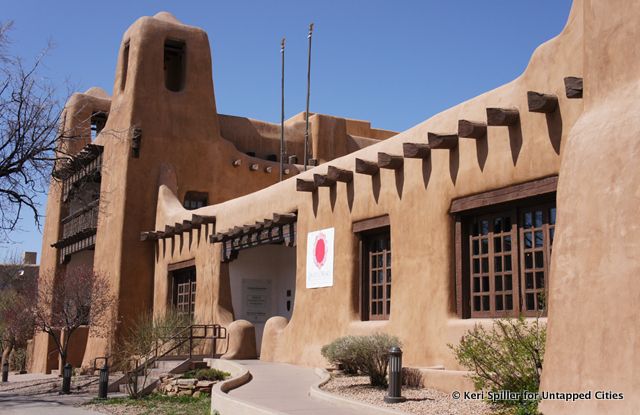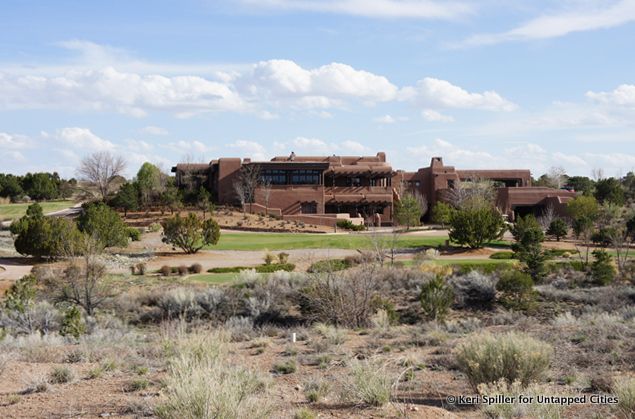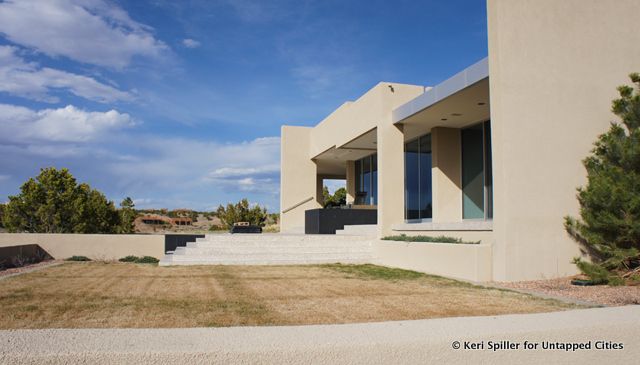Last-Minute NYC Holiday Gift Guide 🎁
We’ve created a holiday gift guide with presents for the intrepid New Yorker that should arrive just in time—



Part three of our series looking at the architecture of Santa Fe.
In 1846, the United States Army claimed all of New Mexico and established an outpost in Santa Fe. Trading routes were well established by then, including the Santa Fe Trail, with Santa Fe literally at the end of the trail. By the time the Americans arrived, it was a thriving industry introducing new goods, products, building materials and building styles. Add to this the Army’s import of Santa Fe’s first power saw, and a new building aesthetic was born: the Territorial Style.
Fitting for the military, their contribution to the architectural fabric of Santa Fe was rooted in the Greek Revival. Elements from this movement adorned adobe structures, such as square portal posts often with details recalling the Greek orders, brick coping details and pediments. This level of adornment and precision had never been seen before in adobe structures. Yet it is as if the adobe, in its fluid manner, allowed these elements to meld in. The result is a distinct style that is still very Southwestern, very Santa Fe.
Not completely devoid of functionality, this new style often included a pitched roof of either shingles or metal. It would become a definitive architectural element throughout northern New Mexico, as it shed rain and snow much more effectively than a flat adobe roof.

Ultimately the bustling trade routes were bulled over by the railroad, and another level of modernization swept across Santa Fe and the west. Though not a stop on the direct line, by the 1880’s Santa Fe was connected to the Union Pacific Railway. This connection coincided with New Mexico’s efforts to attain statehood. Santa Fe embraced the hasty influx of manufactured building products brought by rail for a whole slew of building styles: Victorian, Italianate, Queen Anne and more. The East encouraged a complete exoneration of adobe, in favor of what was viewed as ‘American;’ officials in Santa Fe complied. Many civic and commercial buildings were simply covered up in a new style, and new homes completely foreign to the Santa Fe context sprung up. But no new style took great hold, instead much of Santa Fe evolved into a disparate hodge-podge of appliqué, and the town wound up in the midst of an architectural identity crisis.
Not helping the situation was an economic downturn due to the departure of the US Army and the re-direction of most rail commerce to stops along the main line, such as Albuquerque and Las Vegas (that’s Las Vegas, NM not NV). City officials needed to revive Santa Fe, but how was the question. Boosting tourism seemed a viable option. Tourism was not new to Santa Fe. There had already been a rush to the Southwest in the 1850’s thanks to Fred Harvey’s promotion of his hotels and restaurants along the rail lines, which included the La Fonda Hotel in the heart of Santa Fe. But rail was no longer a resource for ample commerce. Santa Fe was due for its own unique draw.
Just as Santa Fe was ‘losing itself’ a particular population of new residents started to embrace what was being lost. Many artists and writers were travelling west ”” and specifically to Santa Fe ”” for a variety of reasons: some sought the fresh, dry air for health reasons; some escaped urbanity and industrialization; some searched for a new way of life; they all embraced the remarkable surroundings, the quality of the light, the unique environment. Santa Fe offered all of this and more: a more organic existence; intense beauty in the landscape; rich creative and crafts traditions. It was a huge departure from anything they had ever known. They decreed to bring back the old Santa Fe.
Incidentally, this was the period of the City Beautiful Movement across the US, from 1900-1910. The backlash of industrialization created a desire for nature, peaceful harmony and beauty. Cities were encouraged to re-beautify. Santa Fe’s city leaders took the opportunity to revive Santa Fe’s indigenous architecture and the city’s old-worldliness, which so appropriately lent itself to the mission of the City Beautiful Movement. They worked with the artist community and others to restore and preserve Santa Fe’s distinct architectural heritage. The approach was unlike other cities, so instead of ‘City Beautiful,’ Santa Fe was coined the ‘City Different.’ Here was a distinct draw for tourists.
City officials and artists may have had different motives for reviving Santa Fe, but both parties were passionate about bringing her back and keeping her back. An official vernacular was developed, culling elements from Santa Fe’s past, to make up what would officially become ‘Santa Fe Style’ and ‘historic.’ Buildings re-configured to be ‘Americanized’ were brought back to their original state. New construction now had a set of guidelines which were rigidly enforced, especially in what was deemed the historical section of town. And in this ‘historical zone’ only two styles of architecture were allowed, period: Spanish/Pueblo Revival and Territorial Revival.
As part of this effort to clearly define Santa Fe style, the Museum of New Mexico searched for buildings which embodied Santa Fe style. One such building was a supply store in Morley, Colorado. Not even in the state of New Mexico, but it was inspired by the San Esteban del Rey Mission Church at Acoma Pueblo, a New Mexican pueblo still thriving today. Its most distinctive feature is the pair of towers flanking the front faà§ade. Other details were quintessential Santa Fe Style, such as exposed vigas, canales, and portals. The overall design became a pinnacle of Santa Fe Style, replicated in massing and detail time and again. The architectural plans were even used to create the New Mexico Building for the Panama-California Exposition in 1915.

More recent renditions of Santa Fe Style have increased in scale and complexity, as technology has allowed and as the city has allowed, at times it hasn’t. Many architects dedicated their entire careers to exploring Santa Fe Style, their works becoming part of the legacy. Projects through the past 100 years embrace Santa Fe Style, but it must be remembered that by 1912 the style was just that, a style. And as a style, it is a visual aesthetic. Architectural and structural integrity no longer come into play with such necessity as in the past.
Adobe construction now consists of cement block or wood framing filled with concrete, finished with layers of lath and plaster and paint. As a result even large scale projects such as hotels and hospitals can be built in the Santa Fe Style. Tom Ford ”” a native Santa Fean ”” has his 40,000 square foot ‘adobe home.’ I’ve never seen it in person, but I’ve googled it, and it too carries the forms and elements of the local vernacular. There are entire residential developments taking a contemporary spin on Santa Fe Style, and high modern interpretations.




The driving factors from which Pueblo architecture arose were limited by building technology of the time and by pure necessity. These factors were rendered irrelevant through the course of time, and some would argue that the pure architecture has been lost. However, the origins of an earthy austerity and sculptural sense still exist. You can feel it.
The elements integrated with these origins culminate into Santa Fe Style. It is a mixture, ‘una mezcla,’ as eclectic as its population. Worthy of preserving, but only recognized as such when its necessity no longer existed. It was brought back and preserved out of desire.
‘You’re not going to make them look new are you?!!” our neighbor asked when she learned we were repairing a few old sheds out back. But of course not! The legacy continues, perpetuating a built environment which recalls the magic of Santa Fe, the old-worldly, other-worldly.
Santa Fe, the City Different.
For further information the following books are fantastic: The Essence of Santa Fe, New Mexico Style, La Casa Adobe, Southwestern Colonial Ironwork
For the first installment of this chronicle click here.
All black and white photographs are courtesy of the New Mexico History Museum Photo Archives.
Follow Untapped Cities on Twitter and Facebook! Get in touch with the author @kerispiller.
Subscribe to our newsletter